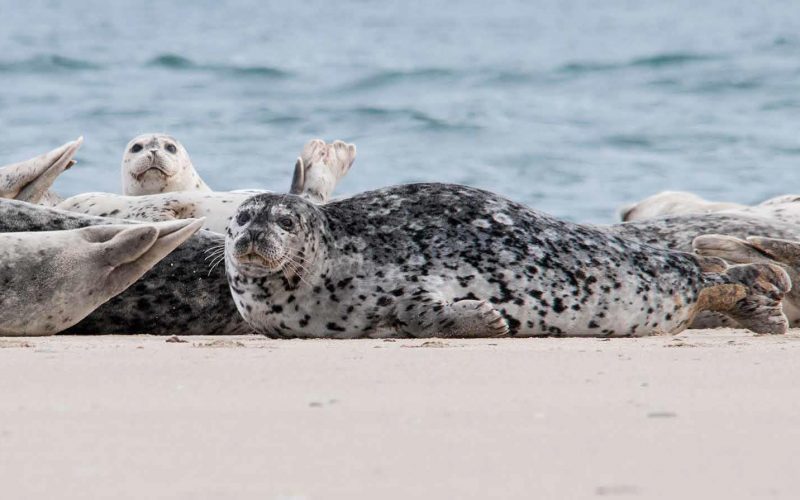STORY BY JENNIFER GERVAIS PHOTOS BY ROY W. LOWE
Curious but shy, these pinnipeds spend time both in the water and on land. They are often seen “hauled out” on rocks or beaches, sleeping or basking in the sun.
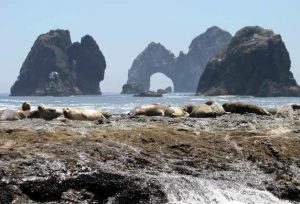
They decorate offshore rocks like salty bananas practicing yoga, balanced with Buddha-like smiles on their faces. When you walk the beach, you might see a round head with large round eyes watching you from the surf, or there might be one eyeing you off the stern of your boat. They can disappear so quietly that you might wonder if you saw a seal at all.
Harbor seals are the smallest of the seal tribe in Oregon, weighing 110 to 375 pounds as adults. They are much less adept on land than their loud-mouthed cousins the sea lions, which can pivot their hind flippers under their body and lope along at an impressive pace. The hind flippers of harbor seals remain straight out behind their bodies. They are forced to wiggle clumsily like giant grubs, their flippers useless for terrestrial movement. In the water, however, they are superb swimmers.
Harbor seals give birth to their pups onshore in late spring and early summer. The pups are born ready for their lives in the water, having already shed their fluffy baby coat, called lanugo, before they leave the womb.
Newborn pups can swim and quickly follow their mothers into the sea. The mother seals do not leave their pups for the first week or more, tending them closely both on land, with other mother-pup pairs, or in quiet waters.
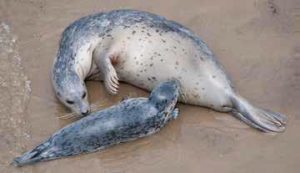
After that, the mother seals need food to produce milk. They leave the pups behind either at a haul-out site or in the water while they forage nearby. One should never approach a baby seal on a beach because the mother seal may abandon her pup after the disturbance.
Physical contact maintains the bond between the mother and her baby. They play together by touching, splashing, twisting around each other, and leaping out of the water. Young seal pups may even ride on their mothers’ backs. Pups help their mothers keep track of them by calling while swimming. The pups’ calls have been described as a sheep-like bleat, “krooroo-uh,” and “kroo-roo.” Adult harbor seals seem to have little to say to each other and get along relatively peaceably on haul-out spots.
Pups grow quickly, putting on about a pound of weight each day. Their mothers wean the pups at three to six weeks, when they are large enough to learn to feed themselves. The mother seal simply doesn’t return one day after going off to fish. This is the most difficult time of life for a seal. Smaller, lighter seal pups are much less likely to make their first birthday than larger pups. The young seals will still need several more years to reach breeding size, and will continue to grow for a few years after that.
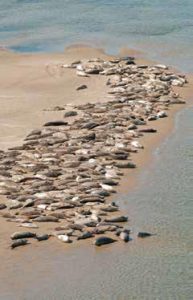
Although they are well adapted to life in the sea, even adult harbor seals come ashore frequently. The Pacific Ocean is very cold, and hauling out allows the seals to rest while using less energy than they need to keep warm in the water. This is particularly important for young seals that aren’t yet skilled hunters and may be barely able to meet their energy needs. In addition, all seals spend a good deal of time on land during late summer and fall. They come ashore to update their attire in a process called molting, when all of their hair is shed and a new coat grows in over several weeks.
The seals raise their skin temperature by nearly 20 degrees to aid in growing the new hair. The seals, therefore, bask more than usual to conserve energy. It is particularly important not to disturb resting seals in summer and early fall for this reason. If the seals suddenly go on alert and all their eyes are on you, you are much too close! Even if you are beyond the 100-yard limit set by the National Marine Fisheries Service, you need to move away at once, before the seals feel forced to enter the water.
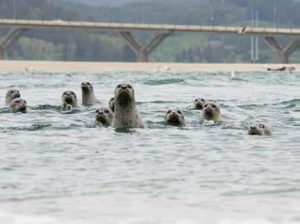
Harbor seals were heavily hunted by people in the last century, with over 1,000 seals killed for bounty in Oregon in 1930 alone. By 1970, researchers estimated that only 500 seals remained along the entire coastline. Since the passage of the Marine Mammal Protection Act in 1972, harbor seal numbers have rebounded to 10,000 or so. It means you stand a good chance of seeing them basking if the tides are low, or swimming along the shore. Looking back to the stern of your kayak, or out over the surf, and seeing a curious, shy face peering back at you is one of the great pleasures of the Oregon coast. ■
FYI
Federal and state law prohibits touching, feeding, or disturbing marine mammals, such as seals and sea lions. In addition, marine mammals that are dead or alive may carry viruses and bacteria that can be transmitted to humans and pets, so keep a safe distance. If you see a marine animal that you think is sick, injured, or stranded, call the Oregon State Police tipline. (800-452-7888)
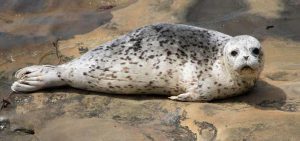
This story appeared in the Spring 2018 issue of Oregon Coast magazine.

